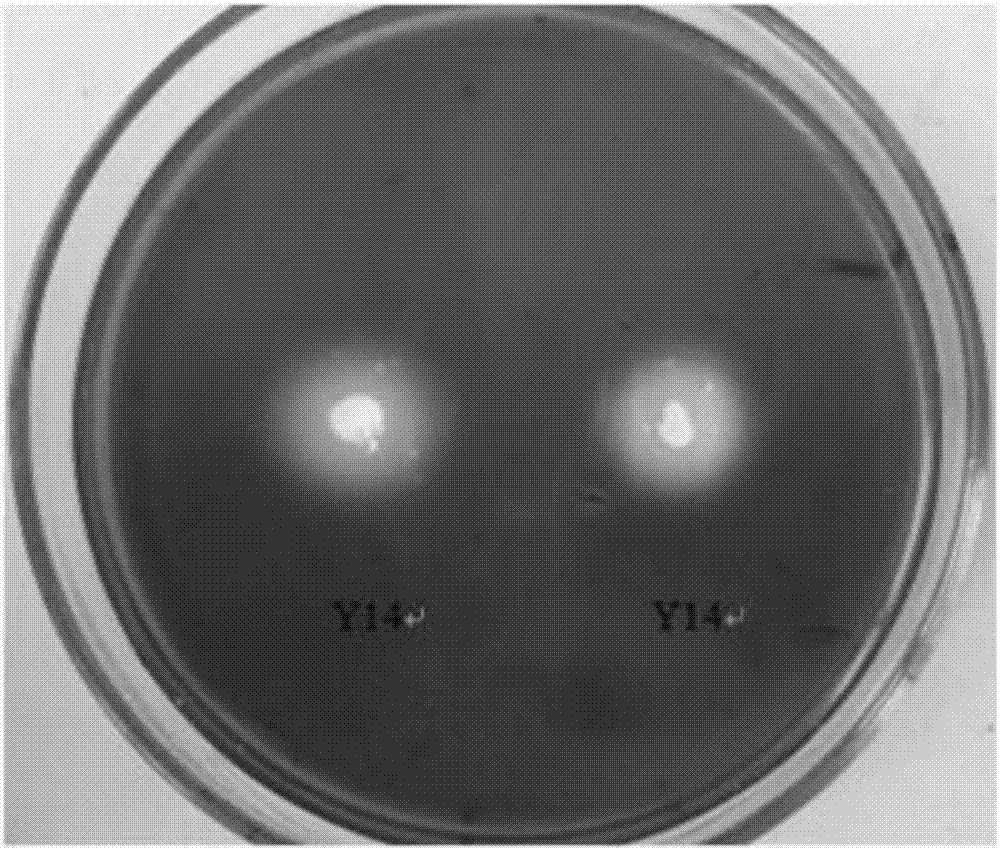Peanut rhizosphere bacillus amyloliquefaciens and application thereof
A technology of amylolytic spores and bacillus, applied in the direction of application, bacteria, biocide, etc., to achieve the effect of improving the microbial community structure, increasing the number, increasing the variety and abundance
- Summary
- Abstract
- Description
- Claims
- Application Information
AI Technical Summary
Problems solved by technology
Method used
Image
Examples
Embodiment 1
[0035] Embodiment 1: Isolation, screening of bacterial strain
[0036] 1. Isolation and screening of strains:
[0037] (1) Isolation of strains
[0038] The strain was sieved from the peanut rhizosphere soil, and the soil samples were collected from the peanut planting field in the suburb of Tai'an City, Shandong Province. Carefully shake off the peanut rhizosphere soil into a sterile bag, put it in a low-temperature fresh-keeping box, and process it immediately after bringing it back to the laboratory. Weigh 10 g of the rhizosphere soil sample, put it into 90 mL of sterile water, and shake it for 30 min to make a microbial suspension. Take 1mL of the suspension respectively, and after diluting according to the 10-fold ratio, take 10 -4 、10 -5 and 10 -6 Spread 200 μL of the double dilution on the beef extract peptone plate, let it stand for 10 minutes, and then place it upside down in a constant temperature incubator at 37°C for about 24 hours. Select representative colo...
Embodiment 2
[0056] Embodiment 2: the preparation of bacterial strain Y14 biocontrol agent
[0057] The specific preparation method is as follows:
[0058] Preparation method of Y14 fermentation broth: transfer the Bacillus amyloliquefaciens Y14 preserved on the slant to a test tube containing 10 mL of liquid LB medium, and place it in a constant temperature shaker for 12 hours (temperature: 37° C.; rotation speed: 180 rpm). Insert the activated bacterium liquid into 200mL liquid LB medium according to the inoculation amount of 1% (volume percentage), put it into a shaker and cultivate it for 24h (temperature: 37°C; rotating speed: 180rpm) to obtain the fermentation liquid of the Y14 strain; as When using biocontrol preparations, dilute the fermentation broth with appropriate amount of sterile water to 1×10 8 cfu / ml is enough.
Embodiment 3
[0059] Embodiment 3: Determination of bacterial strain Y14 inhibiting the growth of the pathogenic bacteria of white silkworm
[0060] 1. Table stand-off test
[0061] (1) Materials and methods:
[0062] Plate confrontation test was used to inoculate the activated peanut white silk mycelium block cut by a sterile puncher in the center of a PDA plate, cultured at 28°C for 1 day, and the antagonistic bacteria Y14 was inoculated at a place about 3 cm away from the edge of the white silk mycelium. Only pathogenic bacteria were inoculated as a control, and the antibacterial effect was observed after 3 days of culture. At the same time, the white silk mycelia at the edge of the confrontation were picked, and the growth and morphological changes of the mycelium were observed under a microscope with the white silk mycelium without antagonistic bacteria as a control.
[0063] (2) Test results:
[0064] Through plate confrontation culture, it was found that the strain Y14 had a signi...
PUM
 Login to View More
Login to View More Abstract
Description
Claims
Application Information
 Login to View More
Login to View More - R&D
- Intellectual Property
- Life Sciences
- Materials
- Tech Scout
- Unparalleled Data Quality
- Higher Quality Content
- 60% Fewer Hallucinations
Browse by: Latest US Patents, China's latest patents, Technical Efficacy Thesaurus, Application Domain, Technology Topic, Popular Technical Reports.
© 2025 PatSnap. All rights reserved.Legal|Privacy policy|Modern Slavery Act Transparency Statement|Sitemap|About US| Contact US: help@patsnap.com



